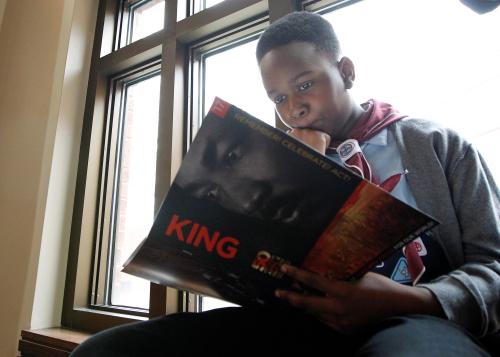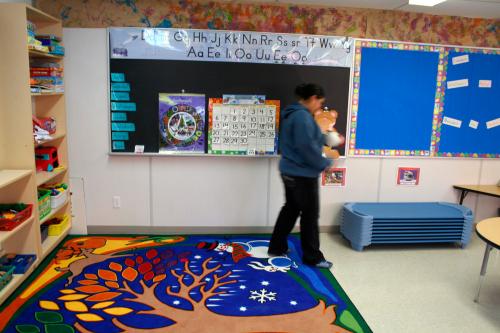W.E.B. DuBois was right about the problem of the 21st century. The color line divides us still. In recent years, the most visible evidence of this in the public policy arena has been the persistent attack on affirmative action in higher education and employment. From the perspective of many Americans who believe that the vestiges of discrimination have disappeared, affirmative action now provides an unfair advantage to minorities. From the perspective of others who daily experience the consequences of ongoing discrimination, affirmative action is needed to protect opportunities likely to evaporate if an affirmative obligation to act fairly does not exist. And for Americans of all backgrounds, the allocation of opportunity in a society that is becoming ever more dependent on knowledge and education is a source of great anxiety and concern.
At the center of these debates are interpretations of the gaps in educational achievement between white and non-Asian minority students as measured by standardized test scores. The presumption that guides much of the conversation is that equal opportunity now exists; therefore, continued low levels of achievement on the part of minority students must be a function of genes, culture, or a lack of effort and will (see, for example, Richard Herrnstein and Charles Murray’s The Bell Curve and Stephan and Abigail Thernstrom’s America in Black and White).
The assumptions that undergird this debate miss an important reality: educational outcomes for minority children are much more a function of their unequal access to key educational resources, including skilled teachers and quality curriculum, than they are a function of race. In fact, the U.S. educational system is one of the most unequal in the industrialized world, and students routinely receive dramatically different learning opportunities based on their social status. In contrast to European and Asian nations that fund schools centrally and equally, the wealthiest 10 percent of U.S. school districts spend nearly 10 times more than the poorest 10 percent, and spending ratios of 3 to 1 are common within states. Despite stark differences in funding, teacher quality, curriculum, and class sizes, the prevailing view is that if students do not achieve, it is their own fault. If we are ever to get beyond the problem of the color line, we must confront and address these inequalities.
The Nature of Educational Inequality
Americans often forget that as late as the 1960s most African-American, Latino, and Native American students were educated in wholly segregated schools funded at rates many times lower than those serving whites and were excluded from many higher education institutions entirely. The end of legal segregation followed by efforts to equalize spending since 1970 has made a substantial difference for student achievement. On every major national test, including the National Assessment of Educational Progress, the gap in minority and white students’ test scores narrowed substantially between 1970 and 1990, especially for elementary school students. On the Scholastic Aptitude Test (SAT), the scores of African-American students climbed 54 points between 1976 and 1994, while those of white students remained stable.
Even so, educational experiences for minority students have continued to be substantially separate and unequal. Two-thirds of minority students still attend schools that are predominantly minority, most of them located in central cities and funded well below those in neighboring suburban districts. Recent analyses of data prepared for school finance cases in Alabama, New Jersey, New York, Louisiana, and Texas have found that on every tangible measure—from qualified teachers to curriculum offerings—schools serving greater numbers of students of color had significantly fewer resources than schools serving mostly white students. As William L. Taylor and Dianne Piche noted in a 1991 report to Congress: Inequitable systems of school finance inflict disproportionate harm on minority and economically disadvantaged students. On an inter-state basis, such students are concentrated in states, primarily in the South, that have the lowest capacities to finance public education. On an intra-state basis, many of the states with the widest disparities in educational expenditures are large industrial states. In these states, many minorities and economically disadvantaged students are located in property-poor urban districts which fare the worst in educational expenditures (or) in rural districts which suffer from fiscal inequity.
Jonathan Kozol s 1991 Savage Inequalities described the striking differences between public schools serving students of color in urban settings and their suburban counterparts, which typically spend twice as much per student for populations with many fewer special needs. Contrast MacKenzie High School in Detroit, where word processing courses are taught without word processors because the school cannot afford them, or East St. Louis Senior High School, whose biology lab has no laboratory tables or usable dissecting kits, with nearby suburban schools where children enjoy a computer hookup to Dow Jones to study stock transactions and science laboratories that rival those in some industries. Or contrast Paterson, New Jersey, which could not afford the qualified teachers needed to offer foreign language courses to most high school students, with Princeton, where foreign languages begin in elementary school.
Even within urban school districts, schools with high concentrations of low-income and minority students receive fewer instructional resources than others. And tracking systems exacerbate these inequalities by segregating many low-income and minority students within schools. In combination, these policies leave minority students with fewer and lower-quality books, curriculum materials, laboratories, and computers; significantly larger class sizes; less qualified and experienced teachers; and less access to high-quality curriculum. Many schools serving low-income and minority students do not even offer the math and science courses needed for college, and they provide lower-quality teaching in the classes they do offer. It all adds up.
What Difference Does it Make?
Since the 1966 Coleman report, Equality of Educational Opportunity, another debate has waged as to whether money makes a difference to educational outcomes. It is certainly possible to spend money ineffectively; however, studies that have developed more sophisticated measures of schooling show how money, properly spent, makes a difference. Over the past 30 years, a large body of research has shown that four factors consistently influence student achievement: all else equal, students perform better if they are educated in smaller schools where they are well known (300 to 500 students is optimal), have smaller class sizes (especially at the elementary level), receive a challenging curriculum, and have more highly qualified teachers.
Minority students are much less likely than white children to have any of these resources. In predominantly minority schools, which most students of color attend, schools are large (on average, more than twice as large as predominantly white schools and reaching 3,000 students or more in most cities); on average, class sizes are 15 percent larger overall (80 percent larger for non-special education classes); curriculum offerings and materials are lower in quality; and teachers are much less qualified in terms of levels of education, certification, and training in the fields they teach. And in integrated schools, as UCLA professor Jeannie Oakes described in the 1980s and Harvard professor Gary Orfield’s research has recently confirmed, most minority students are segregated in lower-track classes with larger class sizes, less qualified teachers, and lower-quality curriculum.
Research shows that teachers’ preparation makes a tremendous difference to children’s learning. In an analysis of 900 Texas school districts, Harvard economist Ronald Ferguson found that teachers’ expertise—as measured by scores on a licensing examination, master’s degrees, and experienc—was the single most important determinant of student achievement, accounting for roughly 40 percent of the measured variance in students’ reading and math achievement gains in grades 1-12. After controlling for socioeconomic status, the large disparities in achievement between black and white students were almost entirely due to differences in the qualifications of their teachers. In combination, differences in teacher expertise and class sizes accounted for as much of the measured variance in achievement as did student and family background (figure 1).
Ferguson and Duke economist Helen Ladd repeated this analysis in Alabama and again found sizable influences of teacher qualifications and smaller class sizes on achievement gains in math and reading. They found that more of the difference between the high- and low-scoring districts was explained by teacher qualifications and class sizes than by poverty, race, and parent education.
Meanwhile, a Tennessee study found that elementary school students who are assigned to ineffective teachers for three years in a row score nearly 50 percentile points lower on achievement tests than those assigned to highly effective teachers over the same period. Strikingly, minority students are about half as likely to be assigned to the most effective teachers and twice as likely to be assigned to the least effective.
Minority students are put at greatest risk by the American tradition of allowing enormous variation in the qualifications of teachers. The National Commission on Teaching and America’s Future found that new teachers hired without meeting certification standards (25 percent of all new teachers) are usually assigned to teach the most disadvantaged students in low-income and high-minority schools, while the most highly educated new teachers are hired largely by wealthier schools (figure 2). Students in poor or predominantly minority schools are much less likely to have teachers who are fully qualified or hold higher-level degrees. In schools with the highest minority enrollments, for example, students have less than a 50 percent chance of getting a math or science teacher with a license and a degree in the field. In 1994, fully one-third of teachers in high-poverty schools taught without a minor in their main field and nearly 70 percent taught without a minor in their secondary teaching field.
Studies of underprepared teachers consistently find that they are less effective with students and that they have difficulty with curriculum development, classroom management, student motivation, and teaching strategies. With little knowledge about how children grow, learn, and develop, or about what to do to support their learning, these teachers are less likely to understand students’ learning styles and differences, to anticipate students’ knowledge and potential difficulties, or to plan and redirect instruction to meet students’ needs. Nor are they likely to see it as their job to do so, often blaming the students if their teaching is not successful.
Teacher expertise and curriculum quality are interrelated, because a challenging curriculum requires an expert teacher. Research has found that both students and teachers are tracked: that is, the most expert teachers teach the most demanding courses to the most advantaged students, while lower-track students assigned to less able teachers receive lower-quality teaching and less demanding material. Assignment to tracks is also related to race: even when grades and test scores are comparable, black students are more likely to be assigned to lower-track, nonacademic classes.
When Opportunity Is More Equal
What happens when students of color do get access to more equal opportunities’ Studies find that curriculum quality and teacher skill make more difference to educational outcomes than the initial test scores or racial backgrounds of students. Analyses of national data from both the High School and Beyond Surveys and the National Educational Longitudinal Surveys have demonstrated that, while there are dramatic differences among students of various racial and ethnic groups in course-taking in such areas as math, science, and foreign language, for students with similar course-taking records, achievement test score differences by race or ethnicity narrow substantially.
Robert Dreeben and colleagues at the University of Chicago conducted a long line of studies documenting both the relationship between educational opportunities and student performance and minority students’ access to those opportunities. In a comparative study of 300 Chicago first graders, for example, Dreeben found that African-American and white students who had comparable instruction achieved comparable levels of reading skill. But he also found that the quality of instruction given African-American students was, on average, much lower than that given white students, thus creating a racial gap in aggregate achievement at the end of first grade. In fact, the highest-ability group in Dreeben’s sample was in a school in a low-income African-American neighborhood. These children, though, learned less during first grade than their white counterparts because their teacher was unable to provide the challenging instruction they deserved.
When schools have radically different teaching forces, the effects can be profound. For example, when Eleanor Armour-Thomas and colleagues compared a group of exceptionally effective elementary schools with a group of low-achieving schools with similar demographic characteristics in New York City, roughly 90 percent of the variance in student reading and mathematics scores at grades 3, 6, and 8 was a function of differences in teacher qualifications. The schools with highly qualified teachers serving large numbers of minority and low-income students performed as well as much more advantaged schools.
Most studies have estimated effects statistically. However, an experiment that randomly assigned seventh grade “at-risk”students to remedial, average, and honors mathematics classes found that the at-risk students who took the honors class offering a pre-algebra curriculum ultimately outperformed all other students of similar backgrounds. Another study compared African-American high school youth randomly placed in public housing in the Chicago suburbs with city-placed peers of equivalent income and initial academic attainment and found that the suburban students, who attended largely white and better-funded schools, were substantially more likely to take challenging courses, perform well academically, graduate on time, attend college, and find good jobs.
What Can Be Done?
This state of affairs is not inevitable. Last year the National Commission on Teaching and America’s Future issued a blueprint for a comprehensive set of policies to ensure a “caring, competent, and qualified teacher for every child,” as well as schools organized to support student success. Twelve states are now working directly with the commission on this agenda, and others are set to join this year. Several pending bills to overhaul the federal Higher Education Act would ensure that highly qualified teachers are recruited and prepared for students in all schools. Federal policymakers can develop incentives, as they have in medicine, to guarantee well-prepared teachers in shortage fields and high-need locations. States can equalize education spending, enforce higher teaching standards, and reduce teacher shortages, as Connecticut, Kentucky, Minnesota, and North Carolina have already done. School districts can reallocate resources from administrative superstructures and special add-on programs to support better-educated teachers who offer a challenging curriculum in smaller schools and classes, as restructured schools as far apart as New York and San Diego have done. These schools, in communities where children are normally written off to lives of poverty, welfare dependency, or incarceration, already produce much higher levels of achievement for students of color, sending more than 90 percent of their students to college. Focusing on what matters most can make a real difference in what children have the opportunity to learn. This, in turn, makes a difference in what communities can accomplish.
An Entitlement to Good Teaching
The common presumption about educational inequality—that it resides primarily in those students who come to school with inadequate capacities to benefit from what the school has to offer—continues to hold wide currency because the extent of inequality in opportunities to learn is largely unknown. We do not currently operate schools on the presumption that students might be entitled to decent teaching and schooling as a matter of course. In fact, some state and local defendants have countered school finance and desegregation cases with assertions that such remedies are not required unless it can be proven that they will produce equal outcomes. Such arguments against equalizing opportunities to learn have made good on DuBois’s prediction that the problem of the 20th century would be the problem of the color line.
But education resources do make a difference, particularly when funds are used to purchase well-qualified teachers and high-quality curriculum and to create personalized learning communities in which children are well known. In all of the current sturm und drang about affirmative action, “special treatment,” and the other high-volatility buzzwords for race and class politics in this nation, I would offer a simple starting point for the next century s efforts: no special programs, just equal educational opportunity.






Commentary
Unequal Opportunity: Race and Education
March 1, 1998